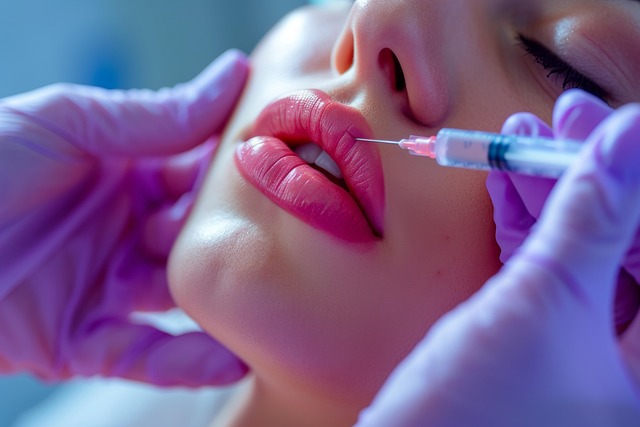Botox, derived from bacteria, is a non-surgical treatment popular for reducing fine lines (crow's feet and smile lines) around eyes and mouth. It paralyzes specific muscles by injecting a protein, smoothing skin and preventing new wrinkles. This natural-looking solution boosts confidence while maintaining a natural appearance. With minimal downtime and quick 15-30 minute treatments, Botox offers a gradual lifting effect for youthful skin without the recovery of more invasive procedures. Potential side effects include temporary redness, swelling, bruising, and slight muscle weakness, but most resolve quickly.
“Uncover the secrets to achieving smooth, youthful skin with Botox—a popular anti-aging treatment. This comprehensive guide navigates the world of Botox for beginners, exploring its science and targeted applications. From tackling crow’s feet and smile lines to understanding non-invasive procedures, we demystify this game-changer. Learn about its effectiveness in reducing wrinkles and what to expect during recovery. Whether you’re considering Botox for crow’s feet or smile line reduction, this article provides valuable insights for informed decisions.”
Understanding Botox: A Simple Guide for Beginners

Botox is a popular solution for those seeking to reduce the appearance of fine lines and wrinkles, especially around the eyes and mouth. For beginners, it’s important to understand that Botox is a protein produced by bacteria that, when injected into specific muscles, temporarily paralyzes them. This action prevents the contraction of these muscles, which are often responsible for forming crow’s feet (fine lines at the corner of the eyes) and smile lines (wrinkles between the eyebrows).
By relaxing these muscles, Botox smoothens out the skin’s surface, giving a more youthful appearance. It is a non-surgical procedure that takes just minutes to perform and offers immediate results. Many people choose Botox for crow’s feet and smile lines as a way to boost their confidence and maintain a natural look.
The Science Behind Botox and Its Anti-Aging Effects

Botox, short for botulinum toxin, is a protein produced by bacteria that has become a popular choice in the quest for youthful-looking skin. When injected into specific muscle groups, Botox blocks nerve signals that cause muscle contraction. This action prevents dynamic wrinkling, particularly around the eyes and mouth—the areas most prone to express emotions like smiling or frowning, which over time can lead to crow’s feet and smile lines.
The science behind its anti-aging effects lies in its ability to temporarily paralyze muscles, reducing the appearance of existing wrinkles and preventing new ones from forming. This non-invasive procedure offers a significant advantage over surgical methods as it provides subtle results, making it an appealing option for those seeking a more natural approach to skincare. For many, Botox is an effective solution for crow’s feet and smile lines, offering both short-term relaxation of muscles and long-term prevention of dynamic wrinkling.
Targeting Crow's Feet: Where and How Botox Works

Crow’s feet, those fine lines that develop at the corner of the eyes and along the forehead from constant smiling and squinting, are a common concern for many individuals seeking smoother skin. This is where Botox for crow’s feet and smile lines comes into play.
Botox, short for botulinum toxin, is a highly effective treatment for these delicate areas. It works by blocking nerve signals to the muscles, temporarily paralyzing them and preventing the contraction that forms wrinkles. When injected by a trained professional, Botox can smooth out crow’s feet and reduce the appearance of smile lines, offering a more relaxed and youthful gaze.
Smile Lines and Frown Line Reduction: Can Botox Help?

Botox has gained significant popularity as a non-surgical aesthetic treatment, especially for those seeking to reduce signs of aging on their face. When it comes to smile lines and frown line reduction, Botox can be an effective solution. These fine lines and wrinkles often appear around the eyes and mouth due to muscle movement and expression. Also known as crow’s feet, these lines can give the appearance of fatigue or age beyond one’s years.
Botox for smile lines works by relaxing the facial muscles responsible for frowning and smiling, preventing the contraction that leads to wrinkling. By injecting a small amount of Botox into specific muscle groups, a trained dermatologist can subtly smooth out these lines, providing a more youthful and rested look. It is important to note that while Botox can significantly reduce the depth and visibility of smile lines, it does not completely erase them. The treatment offers a natural-looking result, enhancing one’s natural beauty rather than altering it.
Non-Invasive Procedures: Benefits of Choosing Botox

Botox has emerged as a popular non-invasive procedure for achieving smoother, more youthful skin, particularly targeting fine lines and wrinkles around the eyes and mouth. This injection treatment works by relaxing specific muscle groups, reducing the appearance of dynamic wrinkles that form over time due to facial expressions like smiling or frowning. By addressing these so-called ‘crow’s feet’ and ‘smile lines’, Botox offers a discreet way to minimize the signs of aging without surgery.
One of the key benefits of choosing Botox is its safety profile. As a highly regulated and well-studied cosmetic procedure, it carries minimal risks when performed by qualified medical professionals. The treatment is quick, usually taking only 15-30 minutes, and most people experience little to no downtime afterward. This makes Botox an attractive option for those seeking a natural, gradual lifting effect without the extensive recovery periods associated with more invasive cosmetic surgeries.
Potential Side Effects and What to Expect During Recovery

While Botox is a safe and effective treatment for reducing the appearance of fine lines and wrinkles, like any medical procedure, it’s crucial to be aware of potential side effects. The most common include temporary redness, swelling, or discomfort at the injection sites, which usually subside within a few days. Some individuals might experience bruising, but this is less frequent. When treating specific areas like crow’s feet and smile lines, you may notice a slight temporal muscle weakness, which can temporarily affect your frowning or smiling ability. This is usually minimal and temporary, resolving within a week or so.
During the recovery period, it’s important to follow post-treatment instructions from your healthcare provider. This typically includes resting and avoiding strenuous activity for a day or two. You should also steer clear of direct sun exposure and avoid making up the treated areas for 24 hours. Keeping your face gently clean and hydrated is recommended. Most side effects are mild and short-lived, allowing you to return to your daily activities shortly after treatment.
